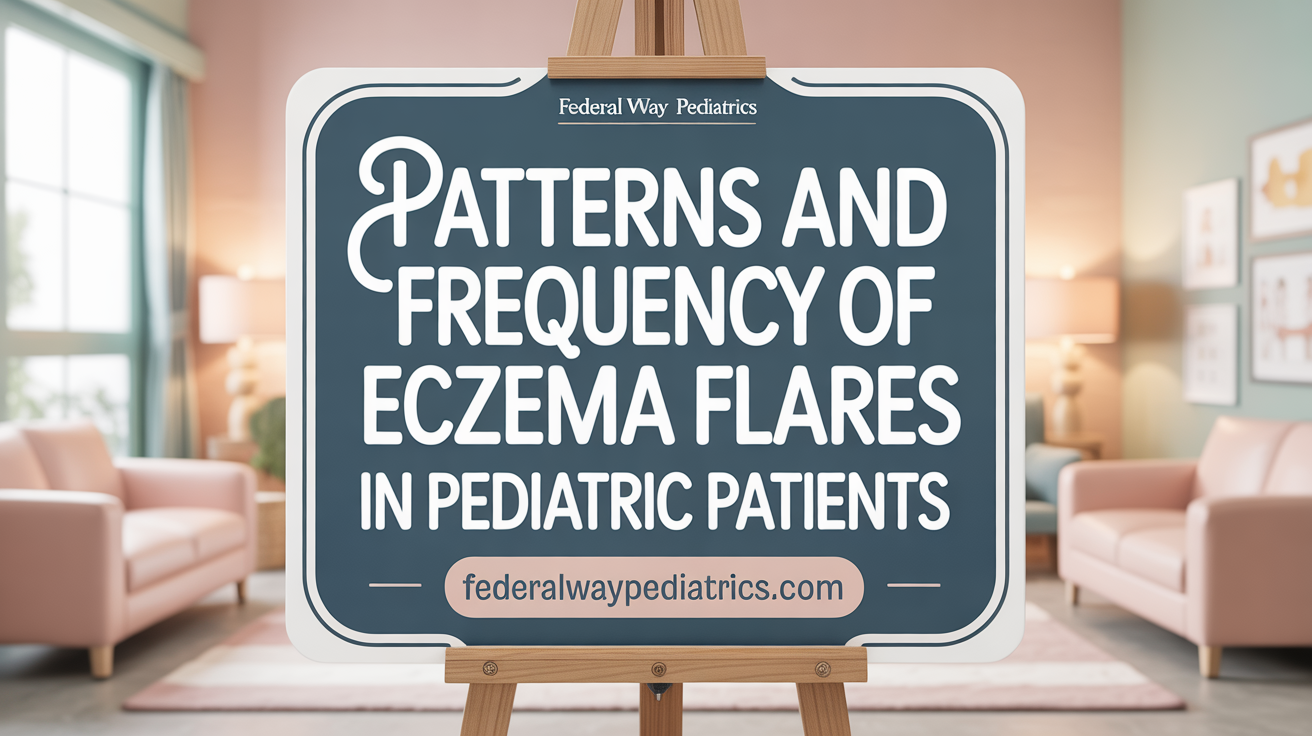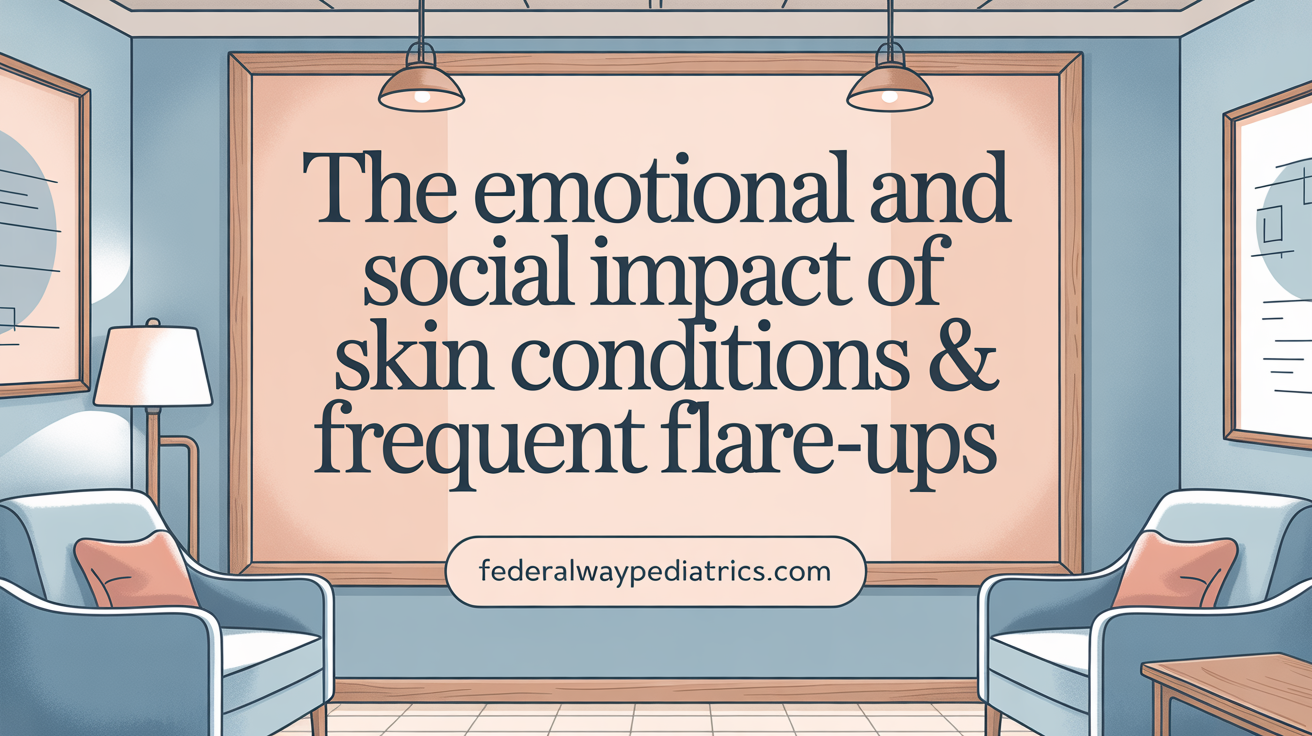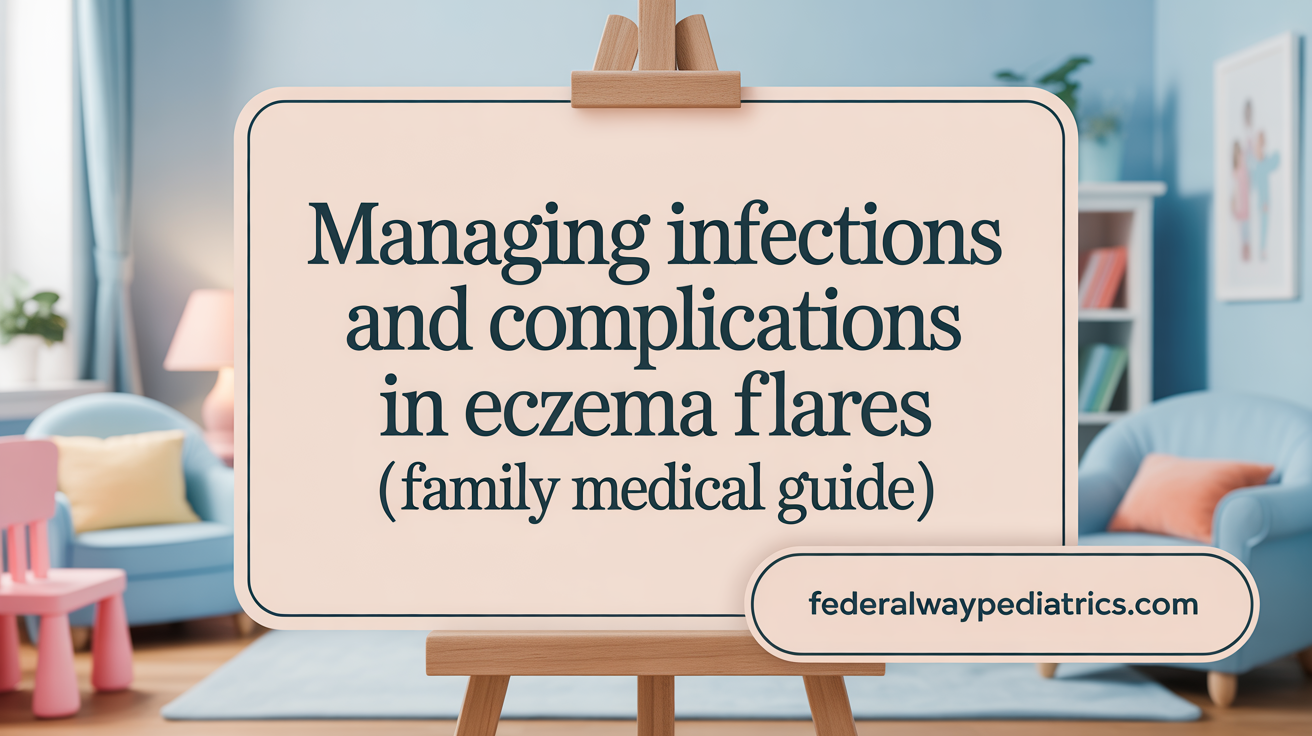Introduction to Eczema in Children and Flare-Up Phenomena
Atopic dermatitis (AD), commonly known as eczema, is among the most prevalent chronic inflammatory skin diseases affecting children worldwide. Beginning often in infancy or early childhood, eczema imposes a significant burden on affected children and their families due to recurrent flare-ups — episodes of sudden symptom worsening — which influence disease progression and quality of life. This article explores pediatric atopic dermatitis, with a particular focus on flare-up frequency, underlying pathogenesis, clinical identification, triggers, management strategies, and current research insights to provide a comprehensive understanding for caregivers and healthcare professionals alike.
Overview of Atopic Dermatitis in Children: Definition and Prevalence

What is atopic dermatitis (eczema) in children, and how common is it?
Atopic dermatitis, commonly known as eczema, is a widespread chronic inflammatory skin disorder that primarily affects children. It is characterized by dry, itchy, red, and inflamed skin, which can lead to discomfort, sleep disturbances, and impact daily life.
Prevalence rates globally and in developed countries
The condition affects approximately 5% to 20% of children worldwide. In the United States alone, around 9.6 million children under 18 live with atopic dermatitis. The prevalence is higher in developed nations and urban areas, where rates can reach up to 20%, and has been steadily increasing over recent decades. In developing regions, the prevalence is growing as well, although it remains lower compared to industrialized countries.
Typical age of onset and disease course
Most cases of atopic dermatitis in children begin early, often before the age of 5, with about 85% of cases developing within the first five years of life. It frequently starts in infancy and tends to subside significantly by age 7, with about 60-70% of affected children experiencing remission. However, a minority may continue to have symptoms into adolescence or adulthood, especially in severe cases.
Understanding this common condition's prevalence and early age of onset underscores the importance of early diagnosis and management to prevent complications and improve quality of life.
| Aspect | Details | Additional Information |
|---|---|---|
| Prevalence in children | 5% - 20% worldwide | Higher in developed countries |
| Most affected age group | Before age 5 | 85% of cases occur in first 5 years |
| Disease course | Often improves or resolves by age 7 | Some cases persist into later years |
| Impact | Sleep disturbances, itching, skin infections | Significant effect on daily life |
This overview highlights the importance of familiarity with atopic dermatitis in children, given its high prevalence and potential to impact growth and development.
Clinical Features and Symptoms of Pediatric Atopic Dermatitis

What are the common symptoms of atopic dermatitis in children?
Children with atopic dermatitis often present with dry, flaky, and cracked skin that can be extremely itchy. The rash typically manifests as redness, which may be purple, brown, or gray depending on the child's skin tone. Small raised bumps are common and can become crusted or leak fluid if scratched excessively.
The most affected areas include the cheeks, scalp, inside the elbows, behind the knees, neck, and around the mouth. During flare-ups, the symptoms tend to intensify, with increased redness, swelling, and itchiness. Persistent scratching can lead to skin thickening or lichenification—a leathery, rough skin texture.
Other signs can include darkening of the skin around the eyes, raw or sore patches due to scratching, and areas of swelling. The presentation varies with age, skin type, and individual sensitivity, and symptoms often wax and wane in episodes known as flare-ups.
Variations in presentation by age and skin type
Infants often experience facial and scalp involvement, with eczema appearing as red, moist patches. Older children may develop more flexural involvement, especially in the crooks of elbows and behind knees.
Children with darker skin tones may show hyperpigmentation or hypopigmentation in affected areas, along with less obvious redness. Skin thickening and lichenification are common in chronic cases.
Impact of symptoms on daily life
The intense itchiness significantly affects a child's daily routine, leading to sleep disturbances, irritability, and difficulty concentrating. The visible skin lesions can also impact self-esteem and social interactions, with some children facing teasing or bullying.
Frequent flare-ups often necessitate ongoing treatment, including the use of moisturizers and anti-inflammatory medications, to manage symptoms and reduce their impact on daily activities and overall well-being.
| Aspect | Description | Additional Details |
|---|---|---|
| Common Symptoms | Dry, itchy skin, redness, bumps | Worsen during flare-ups; varies by skin tone |
| Typical Affected Areas | Face, scalp, elbows, knees, neck | Location depends on age and severity |
| Skin Changes | Thickening, lichenification, hyperpigmentation | Result of chronic scratching |
| Impact on Life | Sleep disturbances, social impact | Affects quality of life and mental health |
Understanding these variations helps in early diagnosis and tailored management to improve the quality of life for children with eczema.
Pathophysiology and Genetic Factors Influencing Pediatric Atopic Dermatitis

Skin barrier dysfunction and genetic mutations
Pediatric atopic dermatitis (AD) often begins with an underlying defect in the skin's barrier function. This barrier disruption allows allergens, irritants, and microbes to penetrate more easily, leading to inflammation. Genetic mutations, particularly in the filaggrin (FLG) gene, play a significant role in this process. Filaggrin is critical for maintaining healthy skin hydration and barrier integrity. Mutations in FLG are associated with increased risk and severity of AD, making affected children more prone to skin dryness, cracking, and allergen exposure.
Immune dysregulation and cytokine profiles
The immune system's response in AD is skewed towards a Th2-dominant profile, especially during acute flare-ups. Cytokines like IL-4, IL-5, IL-13, and IL-31 promote inflammation and itch. IL-31, in particular, contributes directly to the sensation of pruritus by activating sensory nerves. During chronic phases, the immune response shifts slightly, involving more Th1 cytokines such as IFN-γ. This cytokine imbalance fuels ongoing skin inflammation, making symptoms more persistent and difficult to control.
Role of skin microbiome and bacterial colonization
The skin microbiome is another important factor in AD. Children with this condition often experience alterations in their skin bacteria, notably colonization by Staphylococcus aureus. These bacteria exacerbate inflammation and can cause secondary infections, leading to worsened symptoms. The defective skin barrier and immune dysregulation create an environment conducive to bacterial overgrowth. Managing bacterial colonization with antimicrobial treatments can help reduce flare severity and frequency, highlighting the importance of skin microbiome health in AD management.
Defining and Identifying Flare-Ups in Childhood Atopic Dermatitis

How can eczema flare-ups be identified and defined clinically in children?
Eczema flare-ups, or exacerbations, in children are typically recognized by a sudden worsening of skin symptoms. Clinicians look for increased redness, swelling, and itchiness, along with the appearance of new or enlarging skin lesions such as bumps, patches, or areas of thickened, flaky, or crusty skin. During a flare, affected skin often appears more inflamed, sore, and may ooze or develop crusts, especially if secondary infection is present.
Assessment involves physical examination, reviewing the child's history of symptoms, and sometimes using standardized severity scoring tools like SCORAD or EASI. Healthcare providers also consider triggers such as environmental factors, allergens, irritants, or stress that may precipitate a flare. Differentiating flare-ups from baseline eczema relies on recognizing these signs of acute deterioration and treatment response. The goal is to identify episodes of increased disease activity quickly to manage symptoms effectively and prevent complications.
What medical terminology describes acute intensification or flare-ups of eczema?
In medical language, these episodes are known as "exacerbations" or "flares." Specifically, for atopic dermatitis, the term "acute exacerbations" is frequently used to describe episodes where inflammation and symptoms like redness, itching, and skin lesions intensify rapidly.
The term "flare" is commonly used in both clinical and patient contexts. It captures the sudden increase in severity and symptoms of eczema. Overall, "eczema flare" or "acute exacerbation" are the precise terms for these episodes, emphasizing their sudden onset and heightened severity.
Frequency and Patterns of Eczema Flare-Ups in Children

What is the typical frequency and pattern of eczema flares in pediatric cases?
In children with atopic dermatitis, the occurrence of flare-ups varies considerably from one individual to another. Some children experience only occasional episodes, often triggered by specific factors such as irritants, allergies, or infections. Others may have more frequent or persistent flare-ups that occur several times a year.
Research suggests that children typically face about nine episodes of flare-ups annually. These episodes can last approximately 15 days each on average, but durations may extend from days to months, especially in severe cases. Flare severity and duration tend to worsen with increased disease activity, with more extensive skin involvement, redness, and itchiness.
Effective skin care routines, avoidance of known triggers, and proper management are crucial in minimizing flare frequency and severity. When maintained well, many children can experience fewer and less intense outbreaks. Conversely, poor control and failure to manage environmental and skin barrier factors can lead to more frequent and prolonged flares.
Therefore, understanding the pattern of eczema in children is key to tailoring treatments that prevent flare-ups and improve their quality of life. Regular use of emollients, adherence to treatment plans, and monitoring for early signs of worsening are strategies that can help reduce the number and impact of these episodes.
Impact of Flare Frequency on Disease Severity and Prognosis

How does flare frequency correlate with future disease severity?
Research increasingly shows that the number of atopic dermatitis (AD) flares experienced annually can predict the overall severity of the condition in the future. Patients with more than 10 flares per year tend to have more severe disease manifestations, including widespread skin involvement and intense itching. These frequent episodes contribute to greater skin barrier disruption, perpetuating the cycle of inflammation and exacerbation.
What is the predictive value of flare characteristics?
Flare features such as frequency, duration, and severity serve as important indicators of disease trajectory. A cohort study involving nearly 900 patients revealed that higher flare frequency and longer-lasting flare episodes are associated with worse patient-reported outcomes, including greater impact on quality of life measures like the Dermatology Life Quality Index (DLQI). Machine learning models further identified flare severity and duration as strong predictors of ongoing disease severity.
Are longitudinal studies providing insight into disease progression?
Long-term observations highlight that controlling flare frequency can modulate disease course. Data suggest that patients with frequent flares tend to experience more persistent and severe AD, emphasizing the importance of proactive management. Effective treatment strategies aimed at reducing flare episodes, such as consistent skin care and targeted therapies, may prevent disease progression and improve long-term outcomes.
| Key Findings | Impact | Additional Details |
|---|---|---|
| High flare frequency | Predicts greater disease severity | Patients with >10 flares/year had worse disease metrics |
| Flare duration and severity | Indicators of ongoing severity | Longer or more intense flares relate to poorer outcomes |
| Longitudinal data | Supports early intervention | Reducing flares can improve disease progression |
Understanding the relationship between flare activity and disease severity underscores the importance of monitoring and managing flare episodes early. Tailored treatment strategies focusing on minimizing flares could significantly alter the prognosis of individuals living with atopic dermatitis.
Triggers and Risk Factors for Eczema Flare-Ups in Pediatric Patients

What triggers or causes eczema flare-ups in children?
Eczema flare-ups in children are often caused by a combination of environmental, internal, and genetic factors. Common external triggers include allergens like pet dander, pollen, dust mites, and certain foods that can provoke immune responses leading to skin inflammation. Irritants such as harsh soaps, shampoos, detergents, and household chemicals are also known to exacerbate eczema symptoms.
Environmental conditions play a significant role. Dry air, cold or hot temperatures, and excessive sweating can strip moisture from the skin, worsening dryness and irritation. Clothing that causes friction or contains irritating materials like wool, polyester, or with rough seams or tags, can further irritate sensitive skin.
Internally, genetic mutations, such as filaggrin gene mutations, impair the skin’s barrier function, making children more susceptible to irritants and allergens. Immune system alterations, especially a skew toward a Th2-dominant cytokine profile involving IL-4, IL-5, and IL-13, contribute to inflammation and hypersensitivity.
Infections also serve as triggers. The presence of Staphylococcus aureus colonization on the skin can worsen inflammation. Viral infections, notably herpes simplex virus, can trigger eczema herpeticum, a severe complication.
Lastly, emotional stress and activities like crying or exposure to saliva may aggravate symptoms in some children. Managing these triggers involves maintaining proper skin hydration, avoiding known irritants, and controlling environmental conditions.
In summary, eczema flare-ups in children result from a complex interplay of external allergens, irritants, genetic predisposition, immune response, and infections. Preventing exposure to these triggers through tailored skin care and environmental management can significantly reduce the frequency and severity of flare-ups.
Clinical and Patient Perspectives on Defining and Managing Flares

How do patients define atopic dermatitis flares?
Patients experiencing atopic dermatitis (AD) often describe a flare as a period when their symptoms worsen significantly, requiring more intensive treatment or attention. These episodes typically involve increased redness, itching, and skin lesions, disrupting daily activities and sleep. Many patients highlight a sudden increase in symptom intensity, with some pointing out that flares lead to feelings of loss of control over their skin condition.
Research efforts aim to gather patient input to create clearer, patient-centered definitions of what constitutes an AD flare. Such definitions emphasize the importance of physical symptoms like worsening rash and itch, as well as the impact on mental and emotional wellbeing. For example, a common consensus involves symptoms taking more attention than normal, increased itchiness, and physical discomfort that interrupts daily life.
How well do patients and healthcare providers agree on the meaning of flares?
While some alignment exists, studies show only moderate agreement between patients and healthcare providers regarding what defines an AD flare. Over 50% of patients report that they and their clinicians share a similar understanding, but a significant portion still experience communication gaps.
Many patients feel that a standardized, patient-centered definition would improve communication, helping them articulate symptom changes more effectively to their providers. Conversely, healthcare providers recognize the importance of understanding patient perceptions but often rely on clinical criteria that may not fully capture individual experiences.
How do definitions influence self-management of atopic dermatitis?
Patients see value in adopting clear, consistent definitions of flares for self-management. A shared understanding can empower patients to recognize early signs of worsening symptoms and respond promptly, such as increasing moisturizing or using topical medications.
Most patients, around 77%, believe that a patient-centered flare definition would facilitate better communication with healthcare providers, potentially leading to more tailored treatment plans. Additionally, two-thirds of patients would find such definitions useful for self-managing their condition, especially in identifying when to escalate care.
In summary, emphasizing patient perspectives in defining flares enhances engagement and fosters better disease control. Developing standardized tools and digital monitoring technologies may further support both patients and clinicians in managing AD effectively.
Assessment Tools and Scoring Systems for Atopic Dermatitis Severity

What are SCORAD, EASI, TIS, and POEM, and how are they used?
Severity assessment of atopic dermatitis (AD) involves various standardized tools that help clinicians evaluate disease activity and impact. The SCORAD (Scoring Atopic Dermatitis) combines extent, intensity, and subjective symptoms like itch to provide a comprehensive severity score. The EASI (Eczema Area and Severity Index) assesses the severity and extent of eczema across different body regions, focusing on redness, thickness, scratching, and lichenification.
The TIS (Treatment of Atopic dermatitis Tool) is a simplified scoring system mainly used in research to track changes over time, while POEM (Patient-Oriented Eczema Measure) is a patient-reported questionnaire capturing the patient's perspective on symptom severity and frequency. These tools vary in complexity and are chosen based on clinical or research needs.
How do flare-ups factor into severity assessments?
Flares, or episodes of worsening symptoms, are central to understanding AD severity. Many scoring systems evaluate includes flare characteristics, such as increase in itch, redness, or lesion extent. For instance, the SCORAD incorporates the extent and intensity of eczema during flares, which signifies disease exacerbations.
Assessment during flare-ups helps determine whether the condition is well-controlled or requires treatment escalation. Patients experiencing frequent and severe flares tend to have higher severity scores, reflecting more significant disease burden and impacting quality of life.
What are the limitations and practical uses of these assessment tools?
While highly valuable, these scores are primarily research instruments and can be time-consuming for routine practice. Their application relies on clinician expertise, and some rely partly on patient reports, which can introduce variability. Although they help standardize severity measurement, individual patient experiences may vary.
In clinical settings, simplified versions or patient-reported measures like POEM are often used for ongoing monitoring. Combining these tools with clinical judgment ensures better management of AD, especially when assessing treatment response or deciding on therapy escalation.
| Tool | Focus | Usage Context | Limitations |
|---|---|---|---|
| SCORAD | Extent, intensity, symptoms | Research and comprehensive patient assessment | Time-consuming, needs clinician training |
| EASI | Severity and extent | Mainly in research, some clinical practice | Less subjective, requires experience |
| TIS | Simple severity score | Research, quick assessments | Less detailed, not comprehensive |
| POEM | Patient-reported symptoms | Routine outpatient monitoring, self-assessment | Subjective, may vary with patient perception |
Understanding the strengths and limitations of these tools can help optimize their use, ensuring better assessment, treatment planning, and ultimately, improved patient outcomes.
Current Guidelines and Recommended Treatments for Pediatric AD Flare-Ups

What are the current guidelines and recommended treatments for managing atopic dermatitis in children?
Treating atopic dermatitis (AD) in children involves a comprehensive strategy focused on controlling symptoms, reducing flare-ups, and improving quality of life. The primary approach emphasizes maintaining skin hydration through regular use of emollients. These moisturizers should be applied frequently, especially immediately after bathing, to create a barrier that prevents moisture loss and helps repair the skin barrier.
During flare-ups, topical anti-inflammatory medications are the mainstay of treatment. Topical corticosteroids are typically prescribed for short-term use, selected according to the severity, age, and locations involved. Lower potency steroids are preferred for young children or sensitive areas, while more potent options may be used on thicker skin areas, under careful supervision to minimize side effects.
Calcineurin inhibitors like tacrolimus and pimecrolimus offer steroid-sparing options, especially useful in sensitive regions such as the face or neck. They are effective in reducing inflammation and controlling flare-ups without some of the side effects associated with corticosteroids.
For children with severe or persistent AD that does not respond to topical therapies, systemic treatments may be considered. Biological agents like dupilumab, a monoclonal antibody targeting specific cytokines involved in AD, are FDA-approved for moderate to severe cases in children over six years old. Other options include JAK inhibitors and phototherapy, administered under specialist care.
Beyond pharmacologic treatments, education on trigger avoidance—such as irritants, allergens, and environmental factors—and proper skin care routines are vital. Managing adherence to therapy and regular follow-up with healthcare providers help prevent severe flares and maintain better disease control.
In summary, current pediatric AD management guidelines recommend a stepwise, patient-centered approach that combines skin hydration, targeted anti-inflammatory treatments, and specialist interventions for refractory cases, all tailored to minimize side effects and optimize outcomes.
Preventive Strategies and the '3-Minute Rule' for Flare Reduction
 Managing atopic dermatitis effectively involves adopting proactive skin care routines that focus on maintaining skin hydration and minimizing triggers. A well-known strategy that helps in reducing flare-ups, especially in children, is the '3-minute rule.' This simple but powerful approach recommends applying moisturizers within three minutes of bathing. Doing so helps lock in the moisture from lukewarm water, thereby reinforcing the skin barrier and preventing dryness—a major contributor to flares.
Managing atopic dermatitis effectively involves adopting proactive skin care routines that focus on maintaining skin hydration and minimizing triggers. A well-known strategy that helps in reducing flare-ups, especially in children, is the '3-minute rule.' This simple but powerful approach recommends applying moisturizers within three minutes of bathing. Doing so helps lock in the moisture from lukewarm water, thereby reinforcing the skin barrier and preventing dryness—a major contributor to flares.
Regular bathing using gentle cleansers and lukewarm water is crucial. It not only cleanses the skin but also prepares it for immediate moisturizing, which is essential to prevent the skin from becoming dry and cracked. The 'Soak and Seal' method, which combines soaking in lukewarm water followed by quick moisturizer application, has proven effective in supporting skin health.
Moisturizers such as emollients are the cornerstone of daily care. Applying ointments, creams, or lotions frequently, particularly after bathing, helps maintain skin hydration and reduce the tendency for flare-ups.
Environmental and behavioral measures also play vital roles. Avoiding known irritants like harsh soaps, perfumes, and allergens, managing stress, and protecting the skin from extreme temperatures can prevent exacerbations. For moderate to severe cases, additional treatments like wet dressings or medicated creams, under healthcare provider guidance, can further mitigate flares.
In summary, the key to minimizing eczema flare-ups involves consistent skin care routines centered around the '3-minute' moisturization rule, gentle cleansing practices, and trigger avoidance. These strategies collectively support skin barrier function and improve overall disease control.
Psychosocial and Quality of Life Impacts of Eczema and Flare Frequency in Children

Effects of chronic itching on sleep and mental health
Chronic itching from atopic dermatitis is one of the most burdensome symptoms, severely affecting children's well-being. Nearly 67% of children with eczema experience sleep disturbances, which can lead to fatigue and mood changes. The ongoing discomfort can also contribute to anxiety and depression, not only in children but also their caregivers. Adults with eczema report higher risks for mental health issues, such as anxiety and depression, with adults being 2.5 to 3 times more likely to experience these conditions. For children, the psychological toll may begin early, influencing emotional development and overall mental health.
Social challenges and bullying risks
Children with severe atopic dermatitis often face social difficulties, including fewer friendships, increased loneliness, and a higher likelihood of bullying. Studies show that 20-40% of affected children face peer bullying, largely due to visible skin changes like redness, cracking, or oozing lesions. These social challenges can diminish self-esteem and lead to social withdrawal, further impacting mental health.
Overall impact on school and family life
Eczema flares can significantly disrupt daily routines. Children may miss school due to uncontrolled symptoms, affecting their learning and social interaction. Parents often experience decreased productivity at work and increased caregiving responsibilities. The recurrent nature of flares — which can occur multiple times a year — adds to the emotional and physical strain on families, highlighting the importance of effective management to improve quality of life.
| Aspect | Effect | Additional Notes |
|---|---|---|
| Sleep quality | 67% of children suffer sleep disturbances | Impacts mood, concentration, daily functioning |
| Mental health | Increased risk of anxiety and depression | Affects emotional development and family dynamics |
| Social interaction | Bullying and social isolation occur | Consequences include low self-esteem |
| Educational impact | Missed school days | Affects academic progress and peer relations |
| Family and caregiver burden | Decreased work productivity; emotional stress | Necessitates supportive interventions |
Understanding these psychosocial effects emphasizes the need for comprehensive management approaches that go beyond physical symptoms. Addressing both medical and emotional needs can help children navigate the challenges of atopic dermatitis, ultimately improving their quality of life and social outcomes.
Complications and Secondary Infections During Eczema Flares

What are common infectious complications in children with AD?
Children with atopic dermatitis (AD) are at an increased risk of developing skin infections due to the compromised skin barrier. Among these, secondary bacterial infections are particularly prevalent. Such infections can lead to worsening symptoms, prolonged flare-ups, and additional treatment challenges.
Role of Staphylococcus aureus and other pathogens
Staphylococcus aureus is the most common bacteria involved in secondary skin infections among AD patients. This bacteria colonizes the skin of up to 90% of individuals with eczema, especially during flare-ups. Its presence can cause increased redness, oozing, crusting, and even skin boils. Other pathogens like beta-hemolytic streptococcus can also contribute, especially in cases of widespread or severe infections.
In addition to bacteria, viral infections such as herpes simplex virus can trigger eczema herpeticum, a serious and contagious complication. Fungal infections are less common but may occur, especially in immunocompromised individuals.
Strategies for infection prevention and management
Prevention begins with maintaining a healthy skin barrier through consistent use of emollients and avoiding known triggers. Regular gentle skin cleansing and prompt treatment of any skin cracks or lesions help reduce bacterial colonization.
When infection is suspected, topical or systemic antibiotics are used, depending on severity. It is crucial to choose antibiotics based on culture results when possible. In the case of Staphylococcus aureus, mupirocin ointment or topical fusidic acid may be prescribed for localized infections.
Infections must be managed carefully to prevent complications like widespread skin damage or systemic illness. Proper hand hygiene, avoiding scratching, and early intervention during flare-ups play vital roles. For recurrent or severe infections, healthcare providers might consider additional therapies to control the underlying eczema and limit bacterial colonization.
By effectively preventing and managing infections, patients with AD can experience fewer flare-ups and better overall skin health, reducing the risk of more serious complications.
Emerging Therapies and Future Directions in Managing Pediatric Atopic Dermatitis

Biologic agents such as dupilumab and nemolizumab
Recent advancements have introduced targeted biologic therapies for moderate to severe atopic dermatitis, especially in children who do not respond well to traditional treatments. Dupilumab, an injectable monoclonal antibody approved by the FDA, blocks IL-4 and IL-13 pathways, effectively reducing inflammation and itch. It is typically prescribed for children over six months with severe disease.
Nemolizumab is another promising biologic that targets IL-31, a cytokine directly involved in pruritus. By inhibiting IL-31, it aims to decrease the intense itching experienced in atopic dermatitis, improving quality of life.
Advances in JAK inhibitors and targeted treatments
Janus kinase (JAK) inhibitors represent a new class of oral medications that interfere with cytokine signaling involved in atopic dermatitis. These drugs can rapidly reduce inflammation and potentially lessen flare frequency and severity. Examples under investigation include abrocitinib and baricitinib. More research is ongoing to confirm their safety and long-term efficacy in pediatric populations.
Targeted treatments are also expanding to include biologics like lebrikizumab and tralokinumab, which specifically inhibit IL-13, further refining personalized therapy options for different patient profiles.
Use of digital health tools and symptom tracking for flares
Digital technologies are increasingly used to monitor atopic dermatitis symptoms and manage flares. Smartphone applications and wearable sensors enable patients and caregivers to track itch intensity, skin redness, and other symptoms daily. This data helps in recognizing early signs of worsening disease and allows for timely interventions.
Some apps include educational resources, medication reminders, and direct communication channels with healthcare providers, enhancing self-management and treatment adherence. These tools facilitate more personalized care and can improve outcomes by providing real-time insights into disease patterns.
| Technology | Function | Benefit |
|---|---|---|
| Symptom tracking apps | Daily symptom monitoring | Early flare detection |
| Wearable sensors | Objective measurement of skin conditions | Accurate, real-time data on disease activity |
| Telemedicine platforms | Virtual consultations and follow-ups | Greater access to specialist care |
Future directions in pediatric atopic dermatitis involve integrating biologic and targeted treatments with digital health tools, creating a comprehensive, patient-centered approach to disease management.
Relationship Between Flare Frequency, Disease Control, and Long-Term Outcomes

How does flare frequency predict disease progression?
Frequent flare-ups in atopic dermatitis (AD) are strong indicators of worsening disease severity over time. Studies have shown that patients experiencing more than 10 flares per year tend to develop more extensive skin involvement, increased symptoms, and lower quality of life scores. Machine learning models highlight that the number, severity, and duration of flares are critical predictors of future disease severity. This means that even in cases initially classified as mild, recurrent flares can signal a trajectory toward more serious, chronic forms of AD.
Why is sustained disease control important?
Maintaining consistent control over AD can prevent the cycle of flare-ups and reduce long-term tissue damage. Longitudinal data suggest that disease stability over time is achievable through effective management strategies that include regular skin hydration, proactive use of topical anti-inflammatory agents, and trigger avoidance. When flares are frequent and severe, they not only amplify symptoms but also significantly impair quality of life, leading to sleep disturbances, emotional distress, and social challenges, especially in children.
What are the clinical implications for therapy escalation?
Recognizing high flare frequency early is vital for treatment adjustments. Patients with recurrent or severe flares may benefit from intensified therapy, such as the addition of systemic or biologic agents like dupilumab, especially if standard topical treatments are insufficient. Addressing flare frequency proactively can help reduce the progression to severe disease, decrease hospitalization rates, and improve overall outcomes. It emphasizes the need for clinicians to monitor flare patterns closely and adapt treatment plans accordingly to prevent long-term complications and improve quality of life.
The Atopic March: Link Between Eczema and Other Atopic Conditions

How is atopic dermatitis linked to asthma and allergic rhinitis?
Atopic dermatitis (AD) is often the first sign of the atopic march, a progression of allergic diseases that typically begins in early childhood. Many children diagnosed with AD later develop asthma and allergic rhinitis. Research shows that approximately 15% of children with eczema may develop food allergies, asthma, or allergic rhinitis later on. These conditions share common immune pathways, especially the skewing towards a Th2 immune response, which promotes inflammation.
The connection is reinforced by genetic factors and immune system alterations. For example, children with mutations in genes like filaggrin, which disrupt skin barrier function, are more prone to develop other allergic conditions. The early impairment of skin barrier allows allergens to penetrate, triggering immune responses that set the stage for respiratory allergies.
Can managing eczema early help prevent other allergies?
Effective management of eczema from the outset may reduce the risk of developing additional atopic conditions. Maintaining skin hydration, avoiding triggers, and controlling flare-ups with appropriate treatments can diminish allergen exposure through the skin. Studies suggest that proactive skin care and early intervention in young children, especially those with a genetic predisposition, might mitigate the severity and progression of the atopic march.
Identifying high-risk children and initiating treatments that restore skin barrier integrity could be pivotal in preventing future allergic diseases. This underscores the importance of early diagnosis and comprehensive management strategies.
What is the genetic and immune basis of the atopic march?
Genetic mutations, such as those affecting the filaggrin gene, contribute significantly to skin barrier defects, predisposing individuals to AD and subsequent atopic conditions. These mutations impair the skin’s ability to retain moisture and fend off environmental allergens.
Immunologically, the transition from acute to chronic AD involves shifts in cytokine profiles, primarily a move from Th2 dominance to a mixed Th1 and Th2 response. Cytokines like IL-4 and IL-13 are central in the early phases, promoting IgE production and inflammation. Over time, cytokines such as IFN-γ (associated with Th1) become involved, which sustain and complicate disease pathology.
Understanding this interplay helps in designing targeted therapies to interrupt the progression of the atopic march. It also highlights the importance of addressing genetic and immunological factors early to prevent the development of asthma and allergic rhinitis in children with eczema.
| Aspect | Details | Additional Notes |
|---|---|---|
| Common conditions linked to AD | Asthma, allergic rhinitis, food allergies | Often develop sequentially in the atopic march |
| Age of onset | Most AD diagnosed before age 2 | Later development of asthma or rhinitis |
| Major genetic factor | Filaggrin gene mutation | Causes skin barrier deficiencies |
| Immune response | Th2-dominated initially, then mixed | Key cytokines: IL-4, IL-13, IFN-γ |
| Management focus | Early skin barrier repair, trigger avoidance | May prevent or delay other atopies |
Role of Patient Education and Self-Management in Flare Control

How can improved communication tools between caregivers and healthcare providers help manage atopic dermatitis?
Effective communication is essential for controlling atopic dermatitis, especially during flare-ups. Patients and parents can benefit from standardized symptom tracking tools, such as symptom diaries or digital apps, which help quantify changes in itch, redness, and skin appearance. These tools enable patients to provide precise information during consultations, ensuring healthcare providers better understand the severity of flares. Improved dialogue facilitates timely adjustments in treatment plans, reducing the duration and intensity of flares.
Why are patient-centered flare definitions important?
Understanding what constitutes a flare from the patient’s perspective promotes better self-management. Many patients describe flares as episodes where symptoms worsen enough to interfere with daily activities, sleep, or emotional wellbeing. Recognizing these signs allows patients to act promptly, whether by increasing emollient use, applying topical steroids, or seeking medical advice. Such personalized definitions also enhance communication with healthcare teams, leading to tailored treatments that effectively reduce flare frequency and severity.
How can supporting adherence and lifestyle changes improve disease outcomes?
Adherence to recommended skin care routines and avoiding triggers is crucial for flare prevention. Patient education programs emphasizing the importance of regular use of emollients, proper bathing practices, and allergen avoidance can significantly decrease flare occurrences. Lifestyle modifications, such as wearing breathable clothes, managing stress, and maintaining a consistent skincare schedule, support long-term control. When patients understand their role in managing the disease, they are more likely to follow treatment plans diligently, resulting in fewer and milder flares.
| Aspect | Benefits | Additional Details |
|---|---|---|
| Communication tools | Better symptom monitoring, timely treatment adjustments | Digital apps, symptom diaries, telemedicine |
| Flare definitions | Improved self-awareness, prompt action | Patient input on symptom changes, daily activity impact |
| Adherence & lifestyle | Reduced flare frequency, better quality of life | Education on skin care, trigger management, routine consistency |
Empowering patients with knowledge and practical tools fosters better self-management, ultimately leading to fewer and less severe atopic dermatitis flares.
Summary and Forward Look: Integrating Data to Improve Pediatric AD Outcomes

What are the impacts of atopic dermatitis (AD) flare frequency and disease severity on patients?
Atopic dermatitis significantly affects the quality of life for children and adults. Frequent flare-ups, which can occur up to 20 times per year, are associated with worsening symptoms, increased skin involvement, and greater burden on mental health. Children facing severe AD may experience social challenges such as fewer friendships, social isolation, and bullying, additionally suffering from sleep disturbances that occur in about 67% of affected children. Adults with moderate to severe AD report severe itch and skin pain, which contribute heavily to their discomfort and mental health issues, including higher risks of anxiety and depression.
Research indicates that the number of flares a patient experiences annually is predictive of overall disease severity. For instance, patients with more than 10 flares per year tend to have more severe disease outcomes and lower quality of life, underscoring the importance of controlling flare frequency.
Why is individualizing treatment plans so important in managing atopic dermatitis?
Because AD varies widely in severity and presentation, personalized treatment strategies are essential. Standard therapies, including emollients, topical corticosteroids, calcineurin inhibitors, and phototherapy, are effective in managing symptoms but often fall short of providing long-term control, especially in severe cases.
Biologics such as dupilumab have revolutionized treatment for refractory cases, particularly in older children and adults. However, treatment effectiveness depends on accurate assessment of disease severity, patient adherence, and prompt management of triggers like infections and allergens. Monitoring tools like SCORAD and patient-reported outcomes like POEM help tailor therapy to individual needs, aiming to reduce flares, improve skin barrier function, and address the psychological and social impacts.
What are future research needs and implications for clinical practice?
Ongoing research focuses on better understanding AD's complex pathogenesis, including skin barrier defects, immune dysregulation, and microbiome alterations. Innovative treatments targeting different pathways—such as biologics, JAK inhibitors, and novel cytokine blockers—are being developed.
Standardizing definitions of flares and integrating digital tools for real-time symptom tracking can improve disease management. Additionally, developing predictive models that incorporate flare frequency and severity data could enable proactive interventions.
Clinically, practitioners should prioritize comprehensive assessments encompassing physical, psychological, and social factors. Emphasizing patient-centered communication and adopting personalized treatment plans will be key to improving long-term outcomes for children with AD.
| Aspect | Focus | Implications |
|---|---|---|
| Flare frequency | Predicts disease severity | Monitor closely to tailor interventions |
| Treatment personalization | Based on severity and triggers | Use of measurement tools and patient feedback |
| Research directions | Biological pathways, digital tracking | Improve understanding and management strategies |
Conclusion: Managing Flare Frequency to Improve Children's Lives
Atopic dermatitis remains a significant pediatric health concern characterized by fluctuating symptoms and frequent flare-ups that deeply affect children's quality of life. Understanding the prevalence, clinical features, triggers, and flare dynamics of eczema enables better management strategies tailored to individual needs. Current treatments emphasizing skin barrier repair, inflammation control, and trigger avoidance, alongside emerging biologics, offer hope for improved disease control. Recognizing flare frequency as a predictor of disease severity underscores the necessity for proactive interventions. Integrated patient education and standardized flare definitions will further empower families and clinicians in optimizing care. Ongoing research will continue to refine approaches, aiming to reduce the burden of eczema flares and enhance outcomes for children worldwide.
References
- Eczema Statistics - National Eczema Association
- Childhood atopic dermatitis: current developments, treatment ...
- Predictors of Flares and Disease Severity in Patients With Atopic ...
- Frequent Flares Could Predict Disease Progression in Atopic ...
- Atopic Dermatitis: Update on Skin-Directed Management: Clinical ...
- Possible progression of atopic eczema
- Atopic Dermatitis: Diagnosis and Treatment - AAFP
- Atopic dermatitis - ScienceDirect.com
- Management of severe, refractory atopic dermatitis (eczema) in ...
